Vista Place Physiotherapy & Sports Injury Centre
Vista Place Physiotherapy & Sports injury Centre is offering Video Appointments (Telehealth)
Telehealth may be the option for you! If you are unable to get to the clinic due to mobility or transportation issues or simply prefer the comfort of being assessed in your own home Vista Place Physiotherapy and Sports Injury Centre is offering telehealth appointments.
Through a secure platform (PIPEDA accredited) you can take part in a video appointment. You and your therapist will see each other through a video platform. In this appointment you will have thorough assessment, will be shown how to do self mobilizations, learn how to release tight muscles, shown exercises for flexibility and strength and educated in pain control.
Many patients have remarked how effective it is and how much better they feel after.
One client’s shoulder flexion range of motion went from 110 degrees of elevation to 150 after one session.
A client was treated for Benign Proximal Positional Vertigo.
Another client had increase ankle range of motion following surgery after one session
All that is required is a device that has Google Chrome or Firefox as the web browser. The therapist will contact you through email and invite you into the virtual appointment room. Once in the room you will be able to see and communicate with your therapist.
The majority of all insurance companies including WCB and MPI are covering Telehealth
If you would like further information you can contact the clinic at 204-253-2165 or email at vistaplacephysio@shawbiz.ca
Spinal/Joint Manipulation/Mobilization
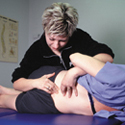 Mobilization is the gentle, rhythmic, repetitive passive movement of graded amplitude aimed at restoring mobility and function and reducing pain in a joint and surrounding tissue. Manipulation is a skilled, passive, quick movement aimed at restoring mobility and function and reducing pain in a stiff joint and associated tissue.
Mobilization is the gentle, rhythmic, repetitive passive movement of graded amplitude aimed at restoring mobility and function and reducing pain in a joint and surrounding tissue. Manipulation is a skilled, passive, quick movement aimed at restoring mobility and function and reducing pain in a stiff joint and associated tissue.
Acupuncture
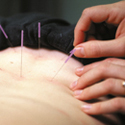 Acupuncture is a therapeutic modality that involves the insertion of very fine sterile disposable needles into the skin and tissues at specific points in the body. There is minimal discomfort associated with the procedure. Acupuncture is a safe and effective way to relieve pain and inflammation associated with acute or chronic injuries. It can be used for a variety of ailments ranging from sports related injuries to arthritis.
Acupuncture is a therapeutic modality that involves the insertion of very fine sterile disposable needles into the skin and tissues at specific points in the body. There is minimal discomfort associated with the procedure. Acupuncture is a safe and effective way to relieve pain and inflammation associated with acute or chronic injuries. It can be used for a variety of ailments ranging from sports related injuries to arthritis.
Dry Needling
Treatment by dry needling is a technique where sterile disposable needles are inserted into trigger points in a muscle. The dry needling not only affects the taut muscle fibers but alters the chemical environment resulting in muscle relaxation. A local twitch response from needling the trigger points decreases activity of the nerves supply the muscle causing muscle relaxation locally and decreases overall widespread pain and sensitivity by altering messages to the brain
Physical Reconditioning
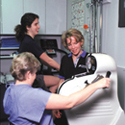 Vista Place Physiotherapy is equipped with exercise equipment designed for physical reconditioning of the muscles, joints and aerobic system. Patients are provided with an exercise program specific to their needs and condition. A team approach is used to encourage adherence to programs for the long term well being of the patient.
Vista Place Physiotherapy is equipped with exercise equipment designed for physical reconditioning of the muscles, joints and aerobic system. Patients are provided with an exercise program specific to their needs and condition. A team approach is used to encourage adherence to programs for the long term well being of the patient.
Post–Surgical Rehabilitation
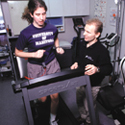 Vista Place Physiotherapy is equipped to begin immediate post-surgical rehabilitation of joint replacements to ensure the best possible outcome.
Vista Place Physiotherapy is equipped to begin immediate post-surgical rehabilitation of joint replacements to ensure the best possible outcome.
Sports Injury Treatment
Sports injury rehabilitations stresses the relationship between exercise physiology, training techniques, sport specific requirements and physiotherapy. At Vista Place Physiotherapy, we strive to get you back to or exceeding your pre-injury status, and return to participation.
Taping
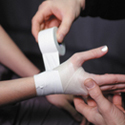 Early immobilization of an acute injury with supportive taping can aid the natural healing process by preventing further undue stress to the area. Taping can help limit abnormal movements of body joints without adversely affecting normal movement or function.
Early immobilization of an acute injury with supportive taping can aid the natural healing process by preventing further undue stress to the area. Taping can help limit abnormal movements of body joints without adversely affecting normal movement or function.
Orthotics
Orthotics are prescribed based on a thorough examination of the entire lower portion of the body from the low back down to the toes. Stiffness in the joints and tightness of muscles of the back and lower limb can affect the mechanics of the foot leading to dysfunction in the foot and subsequent pain. Properly made orthotics can provide shock absorbtion, allow the foot to function properly, and provide a stable base of support for the body.
Massage Therapy
Massage therapy is a means of manually stimulating all the systems of the body through soft tissue work, exercise and stretching.
Functional Movement Screens
The Functional Movement Screen (FMS) assesses movement patterns, it is a screen of coordinated full body movements. The tests place individuals in positions that stress their stability, mobility and balance and can identify those who use compensatory movements or are asymmetrical from right to left side of their body. This screen was developed by Gray Cook and Lee Burton.
Concussion Treatment
See blog (/post-concussion-assessment-and-treatment) for more information.
Vestibular Rehabilitation
WHAT IS VESTIBULAR REHABILITATION?
Vestibular rehabilitation (VR), or vestibular rehabilitation therapy (VRT) is a specialized form of therapy intended to alleviate both the primary and secondary problems caused by vestibular disorders. It is an exercise-based program primarily designed to reduce vertigo and dizziness, gaze instability, and/or imbalance and falls. For most people with a vestibular disorder the deficit is permanent because the amount of restoration of vestibular function is very small. However, after vestibular system damage, people can feel better and function can return through compensation. This occurs because the brain learns to use other senses (vision and somatosensory, i.e. body sense) to substitute for the deficient vestibular system. The health of particular parts of the nervous system (brainstem and cerebellum, visual, and somatosensory sensations) is important in determining the extent of recovery that can be gained through compensation. (Vestibular Disorders Association)
The goal of VRT is to use a problem-oriented approach to promote compensation. This is achieved by customizing exercises to address each person’s specific problem(s). Therefore, before an exercise program can be designed, a comprehensive clinical examination is needed to identify problems related to the vestibular disorder.
Depending on the vestibular-related problem(s) identified, three principal methods of exercise can be prescribed:
- 1) Habituation
- 2) Gaze Stabilization, and/or
- 3) Balance Training
Temporomandibular Dysfunction (TMD)
 Utilizing assessment techniques to identify altered movement patterns, myofascial trigger points and joint restrictions. From the examination findings will design rehabilitation programs that focus on addressing patient-specific impairments.
Utilizing assessment techniques to identify altered movement patterns, myofascial trigger points and joint restrictions. From the examination findings will design rehabilitation programs that focus on addressing patient-specific impairments.
Treatment may include: joint and soft tissue mobi-lization, trigger point dry needling, friction mas-sage, therapeutic exercise, patient education, and modalities Management options would address both symptom reduction and oral function.
